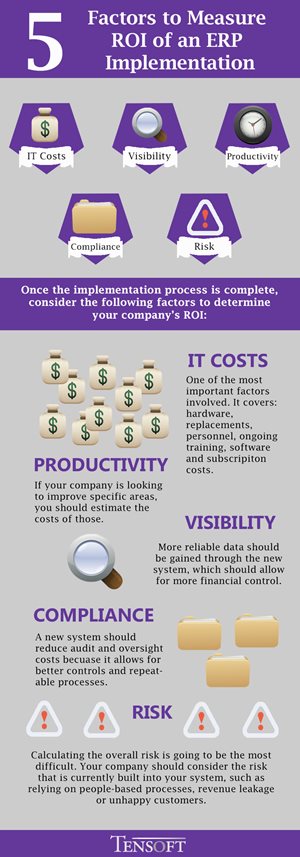A question that we’re often asked is: “How do you estimate the anticipated ROI of an ERP system, and what methodology works best for this?” There are five main areas that should be evaluated to determine this: 1) IT costs, 2) productivity, 3) visibility, 4) risk, and, 5) audit and compliance impacts. Here are some things to consider in each of these key areas –
IT Costs: Although this may be the most easily measured factor involved, it can be complex to caluculate correctly. Hardware costs, replacement costs, personnel costs, ongoing training costs, related services costs, software and subscription costs should all be considered and included in your determination of your IT costs.
Desired Productivity Impacts: If there are specific areas where you are looking to improve team productivity and effectiveness, you can – and should – estimate the impact of better system support or better integration. Be sure to include the impact of data errors and the time required to correct these in un-integrated systems, since this has an important impant on ROI.
Visibility Impacts: Financial control is gained through better information and more reliable data. You should expect your new ERP system to provide better data and better access to that data, even if it isn’t possible for you to get reliable data now. This impacts financial visibility, frequently in a significant way. Additionally, having better visibility impacts how fast data moves through your organization, including how fast it gets to the right people, which is a measurable value.
Audit and Compliance Impacts: Better controls and repeatable processes reduce audit and oversight costs, which will increase your ROI. Whether GAAP, ISO, or whatever industry requirements you have, compliance requirements are often better served with a new system. You can save money through lower oversight and review costs, and you can also make more money by better demonstrating quality controls that make a favorable impression on your customers.
Risk Impact: This very real cost is often the hardest to estimate. You’ll want to carefully consider how much risk is built into your current system. There are risks to relying on people-based processes where you are highly dependent on specific people or specific skills sets for some company functions. There’s the risk of revenue leakage or unhappy customers, since poor administration execution has an impact on customer satisfaction. And, never underestimate the risk of an older system crashing, especially if you are running an unsupported version.
Your business can be impacted by an ERP system implementation quite broadly, and sometimes in unexpected ways. Not all of the impacts are easily measured, but an ROI analysis can be a helpful starting point. You will, of course, need to apply your best judgment based on your specific situation.
At Tensoft, we understand that selecting an ERP system is a substantial investment, not just financially, but of your time as well. The impact of this time and money consuming process can be mitigated by estimating the ROI before selecting and purchasing an ERP system. With many ERP systems on the market, selecting an ERP system can be overwhelming and complex. However, with these tips, you now have some of the tools and a better understanding of ROI methodology to enable you to choose the best ERP system for you and your company. For more information about Tensoft’s products and services, please contact us.
Find out more:
